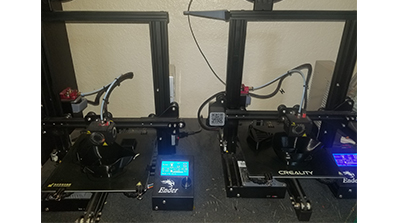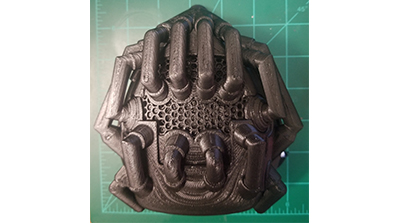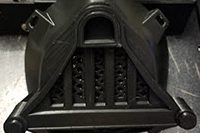When NNSS Principal Scientist Eric Dutra settled into his at-home office, which was occupied by two 3D printers, he decided to transform a hobby into a project: printing Darth Vader–style masks for his wife and friends who work in health care.
Dutra had used his printers for minimal prototyping work, but he says that his interest is mostly in creating models and paintings. At the start of the COVID-19 pandemic, Dutra learned that a nearby university was trying to rapid prototype N95 masks to meet demand and reduce the shortage. Dutra was able to download the file and print one of the masks, and said, “Well that’s cool, but…” Then his friend, who works at Kaiser Permanente Hospital, sent him a picture of a respirator-style mask with a Darth Vader twist. Dutra needed no further prompting. Long a Star Wars fan, Dutra immediately downloaded a file and began to print his first set of two masks, which he delivered to his friend and friend’s girlfriend who wore them to work. He also made one for his wife, Heather, and a scaled-down version for his daughter, Jillian. The reaction was positive.
“Then all of a sudden a lot of people wanted them,” said Dutra. “It was right at the time that everyone was told they needed to wear a mask. It’s a stressful time, and the masks could at least be fun or a little goofy to lessen the tension.”

Dutra has many friends who work for other Bay Area hospitals, including the Stanford Medical Center, Sutter Hospital, and Kaiser Permanente, who are now donning his Darth Vader mask with their own N95 filters tucked behind.
The Darth Vader mask consists of three parts that print at the same time. It takes a little more than 12 hours to print one mask. Dutra originally altered the layer height setting from other projects to reduce print time and resolution, and he thinks he can cut print time in half if he were to make more adjustments. Dutra commented that most hobbyist 3D printers are not really plug-and-play devices, unlike those used in commercial ventures.
“There is a lot of fine-tuning you have to do in the slicer software, which has numerous settings, all of which need to be optimized for good quality print,” said Dutra. But once that is done, the time it takes for Dutra to get a print going and assemble a mask is only about five minutes. Each mask costs less than $2.50 to print. One drawback is the printer motors emit a high-pitched whine, so Dutra often uses an ear bud in his left ear if he’s working, though most of the printing occurs in non-working hours.

Not surprisingly, Dutra’s favorite Star Wars character is Darth Vader. “He’s my favorite,” he chuckled. And he can’t stop quoting his lines from the films (“No, I am your father!”) when he puts on his mask.
With the popularity of the Vader mask growing, requests for other famous character masks started coming in. Dutra is excited about the prototype he developed to create a Bane, a DC Comics/Batman character, mask.
Full masks are not the only thing Dutra has printed. He relates that he has also been “making these thin mask holders that work with the typical masks that all nurses and doctors wear that have straps that go behind the ears.” With this flexible plastic piece, the straps hook on the tabs, which gives overworked ears a break. “I make about a dozen of these a week,” Dutra said. His wife and friends hand them out to hospital workers.
To date, Dutra has printed more than two dozen masks for friends and their family members. Dutra doesn’t accept any money for the masks, supplying them on request. Besides being fun, he says making the masks gives him a feeling of accomplishment.

